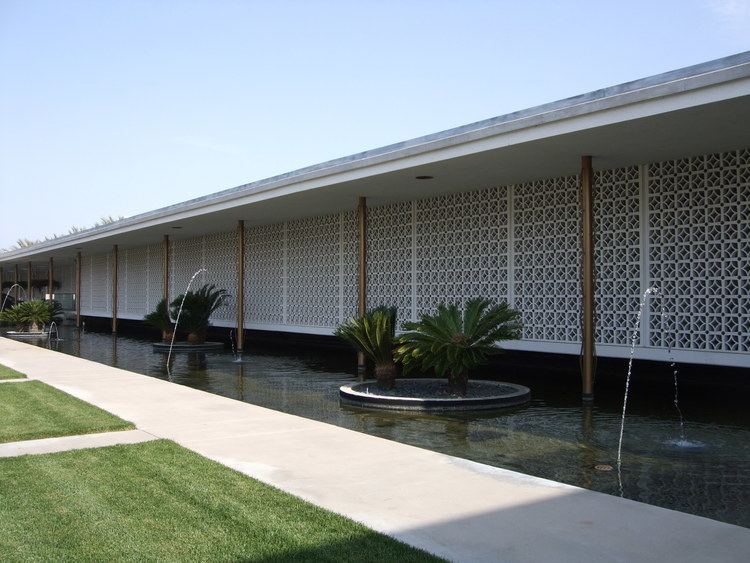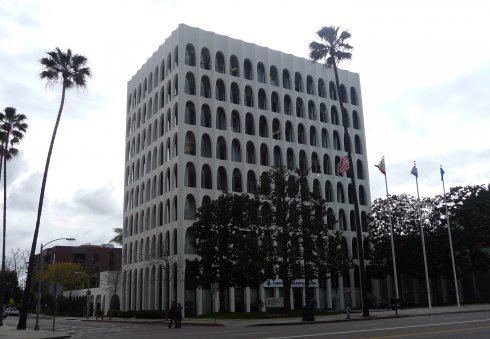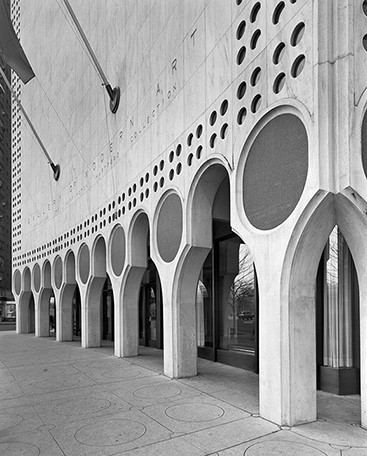Nationality American Role Architect | Name Edward Stone Occupation Architect | |
 | ||
Education Massachusetts Institute of Technology, Boston Architectural College, Harvard University, University of Arkansas Structures Museum of Modern Art, 2 Columbus Circle, Aon Center, Radio City Music Hall, John F Kennedy Center for Similar People Brad Cloepfil, Edward Durell Stone - Jr, Philip Johnson, Paul Rudolph, Yoshio Taniguchi | ||
Children Edward Durell Stone, Jr. | ||
Mary anne hunting edward durell stone modernism s populist architect
Edward Durell Stone (March 9, 1902 – August 6, 1978) was a twentieth century American architect. An early proponent of modern architecture in the United States, he designed buildings throughout the world. Stone’s notable works include Radio City Music Hall and the Museum of Modern Art, both in New York City, and the United States Embassy in New Delhi, India.
Contents
- Mary anne hunting edward durell stone modernism s populist architect
- Dr mary anne hunting presents alumni lecture on edward durell stone at vanderbilt university
- Early Life and Education
- Practice
- Educational Work
- Personal life
- Reputation
- Legacy
- Honorary degrees
- Memberships and honors
- Architectural awards
- Selected works
- References

Dr mary anne hunting presents alumni lecture on edward durell stone at vanderbilt university
Early Life and Education

Stone was born and raised in Fayetteville, Arkansas. His family, early settlers of the area, were prosperous merchants. He entered the University of Arkansas in 1920, but left after two years and moved to Boston to pursue a career in architecture. He studied at the Boston Architectural Club (now Boston Architectural College), and later attended Harvard University and MIT, but did not earn a degree. Though his interest was in modernism, Stone’s education was rooted in Beaux-Arts architecture. In 1927 he won the Rotch Travelling Fellowship (now called the Rotch Travelling Scholarship), which afforded him the opportunity to travel throughout Europe on a two-year stipend. He chronicled his travels in sketchbooks and watercolors in the fashion of a Beaux-Arts student. While in Europe he visited works by some of the foremost modernist architects of the period. Many of these buildings would later be featured in the 1932 International Style exhibit at the Museum of Modern Art. The International Style would influence Stone’s early practice.
Practice
Stone returned to the United States in October 1929 and took up residence in Manhattan. Hired by the firm of Schultze and Weaver, his first job was designing interiors for the new Waldorf-Astoria Hotel. He subsequently worked for the Associated Architects of Rockefeller Center and became the principal designer of Radio City Music Hall. His first independent commission was the Richard H. Mandel House in Mount Kisco, New York (1933), a volumetric design with elements suggestive of the European modernists Willem Dudok and Le Corbusier. The success of the Mandel house, and other prominent early commissions, led to Stone’s appointment as associate architect for the Museum of Modern Art in New York City (1937), designed in collaboration with Philip Goodwin. Stone also designed a private residence for MoMA president Anson Conger Goodyear in Old Westbury, NY (1938). The Goodyear house incorporated floor-to-ceiling glass walls and a flat roof supported on thin metal columns in the manner of Ludwig Mies van der Rohe. The Mandel and Goodyear residences are both listed on the National Register of Historic Places.

Stone’s enthusiasm for the International Style had waned by the 1940s as he found new inspiration in American vernacular architecture and the work of Frank Lloyd Wright. At the outbreak of World War II, Stone closed his practice and enlisted in the U.S. Army. Promoted to the rank of major, he became chief of the Army Air Force Planning and Design Section and supervised the design of major airfields across the United States. Following his honorable discharge from the Army, Stone reopened his architectural office in New York City. His postwar houses continued to explore Wrightian motifs, rustic materiality, and modular design.

The scope of Stone’s practice expanded in the late 1940s. His ten-story El Panama Hotel in Panama City, Panama (1946), was oriented to the prevailing trade winds and employed open, single-loaded breezeways so that guest rooms could be cooled by natural ventilation instead of air conditioning. The University of Arkansas Fine Arts Center in Fayetteville (1948) won praise for its deft handling of a complicated program as well as for the excellence of the facilities it provided. Stone served as associate architect for major health care centers such as the University of Arkansas Medical Center in Little Rock, AR (1950) and the Hospital del Seguro Social del Empleado in Lima, Peru (1950). Hospitals that emphasized a humane environment by opening patient rooms to landscaped courts and gardens became a specialty of the Stone office.

The Embassy of the United States in New Delhi, India (1954) would be Stone’s signature work; a building that fused the formalism of his Beaux-Arts training with a romantic historicism. Set on a podium, the elegantly detailed embassy resembled a temple, yet it was a sophisticated and environmentally-sensitive structure that employed passive solar controls and natural ventilation to reduce air conditioning loads. At the core of the building was a shaded atrium with a large reflecting pool and fountains. For additional shade and security, Stone enclosed the embassy in a two-story pierced grille of patterned terrazzo blocks that were cast on site. Stone’s embassy was widely praised; Frank Lloyd Wright called it one of the most beautiful buildings he had ever seen. The embassy won a first honor award from the American Institute of Architects.
The New Delhi Embassy was a radical departure from the mainstream of modern architecture, and influenced the development of an architectural style that came to be known as New Formalism. Stone established himself as one of the leading formalists with a series of extensively published buildings such as the Stanford University Medical Center in Palo Alto, CA (1955), the Stuart Pharmaceutical Company in Pasadena, CA (1956), and the United States pavilion at the 1958 Brussels World’s Fair (1957). In 1958 Stone was elected to the College of Fellows of the American Institute of Architects. He was also the subject of a Time magazine cover story. His office began to receive larger and more prestigious commissions, entering a period of rapid expansion.
Guided by a comprehensive knowledge of architectural history, Stone sought to achieve a sense of permanence in his buildings. “I think of architecture as an enduring art," he said. "I am fond of saying that architecture should not attempt to be what is currently fashionable....It should not be influenced by transitory mannerisms. This is what I strive for. I try to do buildings that I think will endure and not be dated.” By the mid-1960s Stone’s firm was among the largest architectural practices in the United States, with over 200 employees and offices on both coasts. His clients included cultural, educational, and religious institutions, government agencies, as well as major corporations. Significant buildings from this period include the North Carolina State Legislative Building in Raleigh (1960), the Pakistan Institute of Nuclear Science and Technology in Nilore (1961), the National Geographic Society building in Washington, D.C. (1961), the Museo de Arte in Ponce, Puerto Rico (1961), the Albany campus of the State University of New York (1962), the John F. Kennedy Center for the Performing Arts in Washington, D.C. (1962), the General Motors building in New York City (1964), and the PepsiCo World Headquarters, in Purchase, NY (1967).
Stone continued to receive important commissions in the early 1970s, such as the Florida State Capital complex in Tallahassee (1970) and the Standard Oil building in Chicago (1970). The latter building, now known as the Aon Center, was among the tallest structures in the world at the time of its completion. Failing health forced Stone to retire from active practice in 1974. He died in New York City in 1978. Following a New York City funeral, Stone was buried in Fayetteville. His firm, Edward Durell Stone & Associates, continued to exist in various forms until 1993.
Educational Work
In addition to his architectural practice, Stone was also devoted to the education of young architects. Stone taught at New York University’s School of Architecture and Applied Arts beginning in 1937, and later became the chief design critic and an associate professor of architecture at Yale’s School of Architecture. He served as a lecturer and visiting critic at other institutions, including the American Academy in Rome, Cornell, Princeton, and Stanford, until the demands of his architectural practice made it impossible for him to do so. He actively supported the establishment of an architectural program at the University of Arkansas. Stone’s work as an educator gave him the opportunity to recruit many skilled young staff members for his office. He also formed bonds with other prominent academics such as Walter Gropius at Harvard, Pietro Belluschi at MIT, George Howe at Yale, and William Wurster at the University of California, Berkeley. Stone's role as an educator was recognized in 1955, when the New York Chapter of the American Institute of Architects awarded him its Medal of Honor, praising Stone as a "distinguished designer of buildings and inspiring teacher.”
Personal life
Stone married Sarah Orlean Vandiver in 1930; they would have two sons. After his first marriage ended in divorce, Stone wedded journalist Maria Elena Torch in 1954. He and Maria would have a son and a daughter before divorcing in 1966. In 1972 Stone married his personal assistant, Violet Campbell Moffat. They had a daughter and were still married at the time of Stone’s death in 1978.
Stone is survived by four of his five children. His eldest son, the late Edward Durell Stone, Jr., was the founder and chairman of EDSA, a planning, landscape architecture and urban design firm based in Fort Lauderdale, Florida. Hicks Stone, his youngest son, is a practicing architect whose firm, Stone Architecture LLC, is based in Connecticut.
Reputation
Stone’s early embrace of the International Style placed him in the vanguard of his profession. Though his buildings were not considered to be pure examples of the style, his work was regularly published in professional journals as well as popular magazines. His buildings continued to be published after he abandoned the International Style in the 1940s, and publication would increase when he embraced New Formalism in the 1950s. His second wife, Maria, made use of her background in journalism to publicize and promote her husband’s career. At her urging, Stone published his memoir, The Evolution of an Architect, in 1962. The book received positive reviews and introduced the architect to a wider audience. In 1962 United Press International called Stone "the most quoted architect since the death of Frank Lloyd Wright.” He received numerous honors and was in demand as a public speaker.
However, with the rapid growth of his practice, a repetitive quality became noticeable in Stone’s designs. Amidst the social turmoil of the late 1960s, his classically inspired Beaux-Arts approach to architecture seemed increasingly anachronistic. By the time his second book, Edward Durell Stone: Recent and Future Architecture, was published in 1967, it had become fashionable to disparage Stone’s work. This hostility was especially evident at the 1971 opening of the John F. Kennedy Center for the Performing Arts. Stone had devoted more than a decade to the project and was hurt by the scathing reviews the building received from architectural critics. The negative opinions that were formed during the late phase of Stone’s career endured long after his death. Yet it should not be forgotten that Stone was held in high regard by many of his contemporaries. Pietro Belluschi wrote, “Many of us consider Stone to be the most imaginative designer of his generation. I have known and admired Ed Stone for many years; to everything he has done he has brought distinction and grace. I had the opportunity to review the work that he did for the Embassy in New Delhi, and I was impressed with the richness and flexibility of his imagination and the quality of his mind, which is free and spirited."
Legacy
Stone donated a portion of his papers to the University of Arkansas in 1975, and his widow Violet donated substantially more material to the collection in 1979. The twenty-first century brought a renewed interest in Stone’s life and work as many of his buildings faced alteration or demolition. After decades of neglect, two new books about Stone were released in the 2010s. Hicks Stone’s Edward Durell Stone: A Son's Untold Story of a Legendary Architect was published by Rizzoli in 2011; Edward Durell Stone: Modernism's Populist Architect by Mary Anne Hunting was published by Norton in 2013.
